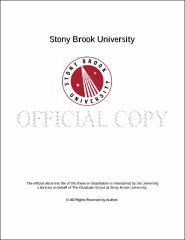| dc.identifier.uri | http://hdl.handle.net/11401/77670 | |
| dc.description.sponsorship | This work is sponsored by the Stony Brook University Graduate School in compliance with the requirements for completion of degree. | en_US |
| dc.format | Monograph | |
| dc.format.medium | Electronic Resource | en_US |
| dc.language.iso | en_US | |
| dc.publisher | The Graduate School, Stony Brook University: Stony Brook, NY. | |
| dc.type | Dissertation | |
| dcterms.abstract | Exploratory synthesis, discovery of novel materials, and characterization of the structure – property relationship drives new technologies that might mitigate major global issues such as climate change. Central to these endeavors are the design of new approaches, apparatus, and improvements in existing sample environments, which allow one to observe the evolution of changes in atomic arrangements directly. The new techniques and strategies decrease the materials discovery-deployment cycle (DDC), a central goal of the Materials Genome Initiative (MGI). The strategies developed and described in this dissertation, are broadly applicable to the MGI. However, they are particularly powerful when applied to: The synthesis and optimization of high-pressure materials, where rank ordering of target compositions, predicting possible structure-types, and in situ observation of the reactions during synthesis can reduce the DDC from months to hours. Two novel oxynitride phases in the GaN – Nb2O5 system were discovered utilizing this approach and are related to the minerals rutile (TiO2) and scruntinyite (α-PbO2). The rapid evaluation of potential candidate compounds for post-combustion carbon dioxide capture was optimized by combining X-ray diffraction and differential scanning calorimetry (XRD-DSC) with techniques for simulating humid environments. These measurements mimic the process of removing carbon dioxide from wet flue-gas and were used to screen prominent microporous compounds for carbon capture under realistic conditions. Finally, new strategies for evaluating the atomic arrangements of minerals and their relation to nanoparticles were developed. An extensive crystallographic investigation of the crystalline mineral akdalaite, the presumed structural analog of the nanomineral ferrihydrite, was undertaken to evaluate the shortcomings of the ferrihydrite structural model. The complete akdalaite structure was characterized for the first time using single crystal X-ray diffraction, powder neutron diffraction, and nuclear magnetic resonance. The akdalaite model compiled from the results confirmed the crystal chemical anomalies in the ferrihydrite structure are indeed real, and not sort comings of the model. | |
| dcterms.abstract | Exploratory synthesis, discovery of novel materials, and characterization of the structure – property relationship drives new technologies that might mitigate major global issues such as climate change. Central to these endeavors are the design of new approaches, apparatus, and improvements in existing sample environments, which allow one to observe the evolution of changes in atomic arrangements directly. The new techniques and strategies decrease the materials discovery-deployment cycle (DDC), a central goal of the Materials Genome Initiative (MGI). The strategies developed and described in this dissertation, are broadly applicable to the MGI. However, they are particularly powerful when applied to: The synthesis and optimization of high-pressure materials, where rank ordering of target compositions, predicting possible structure-types, and in situ observation of the reactions during synthesis can reduce the DDC from months to hours. Two novel oxynitride phases in the GaN – Nb2O5 system were discovered utilizing this approach and are related to the minerals rutile (TiO2) and scruntinyite (α-PbO2). The rapid evaluation of potential candidate compounds for post-combustion carbon dioxide capture was optimized by combining X-ray diffraction and differential scanning calorimetry (XRD-DSC) with techniques for simulating humid environments. These measurements mimic the process of removing carbon dioxide from wet flue-gas and were used to screen prominent microporous compounds for carbon capture under realistic conditions. Finally, new strategies for evaluating the atomic arrangements of minerals and their relation to nanoparticles were developed. An extensive crystallographic investigation of the crystalline mineral akdalaite, the presumed structural analog of the nanomineral ferrihydrite, was undertaken to evaluate the shortcomings of the ferrihydrite structural model. The complete akdalaite structure was characterized for the first time using single crystal X-ray diffraction, powder neutron diffraction, and nuclear magnetic resonance. The akdalaite model compiled from the results confirmed the crystal chemical anomalies in the ferrihydrite structure are indeed real, and not sort comings of the model. | |
| dcterms.available | 2017-09-20T16:53:17Z | |
| dcterms.contributor | Parise, John B | en_US |
| dcterms.contributor | Liebermann, Robert | en_US |
| dcterms.contributor | Ehm, Lars | en_US |
| dcterms.contributor | Glotch, Timothy | en_US |
| dcterms.contributor | Forster, Paul. | en_US |
| dcterms.creator | Woerner, William Richard | |
| dcterms.dateAccepted | 2017-09-20T16:53:17Z | |
| dcterms.dateSubmitted | 2017-09-20T16:53:17Z | |
| dcterms.description | Department of Geosciences. | en_US |
| dcterms.extent | 178 pg. | en_US |
| dcterms.format | Application/PDF | en_US |
| dcterms.format | Monograph | |
| dcterms.identifier | http://hdl.handle.net/11401/77670 | |
| dcterms.issued | 2015-12-01 | |
| dcterms.language | en_US | |
| dcterms.provenance | Made available in DSpace on 2017-09-20T16:53:17Z (GMT). No. of bitstreams: 1
Woerner_grad.sunysb_0771E_12556.pdf: 9182462 bytes, checksum: 046477ac9e0b371549164ef48ef75a2b (MD5)
Previous issue date: 1 | en |
| dcterms.publisher | The Graduate School, Stony Brook University: Stony Brook, NY. | |
| dcterms.subject | Geochemistry | |
| dcterms.title | In Situ Scattering and Modeling Approaches for the Discovery and Optimization of Novel Mineral-Inspired Materials | |
| dcterms.type | Dissertation | |

